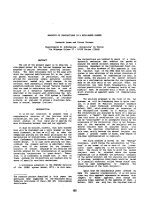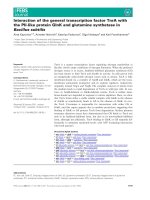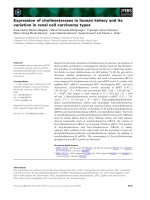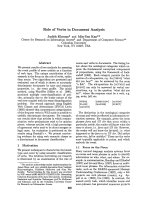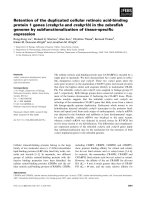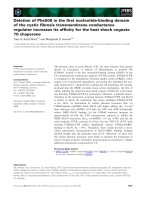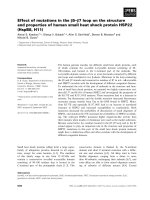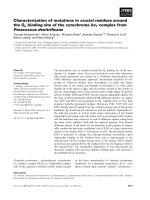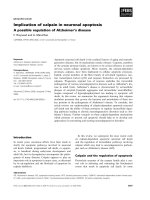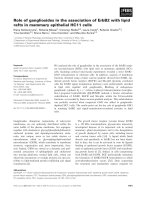Báo cáo khoa học: "Variation of growth in Danish provenance trials with oak (Quercus robur L and Quercus petraea Mattuschka Liebl" pptx
Bạn đang xem bản rút gọn của tài liệu. Xem và tải ngay bản đầy đủ của tài liệu tại đây (268.51 KB, 5 trang )
Original
article
Variation
of
growth
in
Danish
provenance
trials
with
oak
(Quercus
robur
L
and
Quercus
petraea
Mattuschka
Liebl)
JS
Jensen
Danish
Forest
and
Landscape
Research
Institute,
Skovbrynet
16,
2800
Lyngby
Denmark
Summary —
In
1990
an
evaluation
was
made
of
all
29
Danish
provenance
trials
with
oak.
For
the
most
part,
north-European
provenances
have
been
used
in
these
trials.
The
paper
presents
results
from
2
provenance
trials
with
respectively
20
and
25
provenances
25
years
of
age
raised
from
seed.
From
these
trials
it
can
be
seen
that
the
provenances
are
divided
into
many
distinctive
ecotypes,
and
differ
with
regard
to
the
time
of
flushing,
volume
yield,
morphological
characteristics,
etc.
High
heritability
values
have
been
found
for
straightness,
tree
height
and
volume
yield
as
well
as
for
flush-
ing,
epicormics
and
axis
formation.
Q
robur /
Q petraea
/
provenance
/ stem
form
/ epicormic
shoot
Résumé —
Variabilité
intraspécifique
de
la
croissance
du
chêne
pédonculé
(Q
robur L)
et
ses-
sile
(O
petraea
[Matt]
Liebl)
au
Danemark.
Les
29
tests
de
provenance
de
chênes
installés
au
Da-
nemark
ont
été
étudiés
en
1990.
Ces
tests
comprenaient
essentiellement
des
provenances
d’Europe
du
Nord.
Les
résultats
présentés
ici
concernent
2
tests
regroupant
20
et
25
provenances
et
âgés
de
25
ans.
ils
montrent
que
les
provenances
se
répartissent
en
différents
écotypes.
Des
variations
im-
portantes
ont
été
observées
pour
le
débourrement,
la
production
en
volume,
la
forme.
Des
valeurs
élevées
d’héritabilité
ont
été
trouvées
pour
la
rectitude
du
tronc,
la
hauteur,
le
volume,
le
débourre-
ment,
les
pousses
épicormiques,
et
la
formation
de
la
tige
principale.
Q
robur
/Q
petraea
/ provenance
/ forme
du
tronc / pousse
épicormique
INTRODUCTION
Due
to
a
lack
of
sufficient
seed
sources
in
Denmark,
there
has
always
been
a
fairly
large
importation
of
acorns
from
different
countries.
Although
the
foreign
provenan-
ces
often
showed
good
form
and
produc-
tion
qualities,
they
frequently
had
frost
die-
back
and
mildew
(Microsphaera
alphi-
toides).
Understanding
this
provenance
problem
led
to
the
establishment
of
prove-
nance
trials
at
the
beginning
of
this
centu-
ry
(Helms,
1909;
Hauch,
1914).
Cieslar
(1923)
described
the
existence
of
different
climate-conditioned
oak
spe-
cies.
He
also
pointed
out
the
presumably
high
maternal
inheritance
for
stem
straight-
ness.
This
was
strongly
supported
by
dem-
onstration
trials
carried
out
by
Oppermann
(1932).
Oppermann
very
carefully
de-
scribed
the
existence
of
various
races
and
form
types
in
Denmark.
Later
on,
other
ge-
netic
properties
of
oak
were
described
by
Schreiber
(1952),
Krahl-Urban
(1959)
and
Kleinschmit
(1977).
Due
to
lack
of
statistical
knowledge,
most
of
the
early
provenance
trials
were
made
without
replications
with
insufficient
possibilities
of
estimating
genetic
gain
of
phenotypic
observations.
The
importance
of
oak
for
production
of
high
quality
wood
and
as
a
stabilizing
and
esthetic
element
of
forests
and
landscapes
has
in
recent
years
increased
interest
in
the
different
properties
of
the
oak
races
used
in
Denmark.
In
1990,
all
Danish
oak
provenance
trials
were
evaluated.
In
this
paper,
results
are
presented
mainly
from
2
young
and
large
trials
with
almost
identical
prove-
nance
compositions.
Due
to
replications,
these
trials
have
formed
a
basis
for
esti-
mating
genetic
gains.
MATERIALS
The
1990
evaluation
included
29
provenance
trials
of
different
experimental
value.
Only
6
of
these
trials
include
replicate
treatments.
All
trials
are
randomly
distributed
throughout
Den-
mark.
Two
of
these
are
described
here
in
more
de-
tail.
In
1967,
2
provenance
trials
were
estab-
lished
in
eastern
Denmark,
including
15/20
provenances
of
presumably
Danish
origin,
4
of
Dutch
origin
and
1
of
German
origin.
All
of
them
are
Quercus
robur,
except
F232
which
is
a
Quercus
petraea
of
German
origin.
Most
of
the
acorns
for
the
provenance
trials
were
collected
from
selected
stands
in
Denmark.
Each
trial
was
designed
as a
complete
4-block
experi-
ment,
each
block
with
20/25
provenances.
Each
plot
included
20-30
trees,
25
years
of
age.
Both
trials
were
established
on
moist
loamy-clayey
soils
which
often
exhibited
pseudogley
tenden-
cies.
METHODS
All
Danish
oak
provenance
trials
were
evaluated
in
1990
and
most
of
the
trials
have
been
meas-
ured
several
times
in
the
past.
The
yield
param-
eters:
height,
diameter
and
standing
volume/ha
were
measured,
and
in
3
trials
the
volume
pro-
duction
could
be
quantified.
The
evaluations
of
qualitative
parameters
included:
stem
straight-
ness,
epicormic
formation,
branch
angle,
stem
axis,
fork
formation
and
flushing.
Contrary
to
the
metric
measurements
of
production,
the
estima-
tion
of
qualitative
parameters
includes
the
use
of
a
non-continuous
scale.
The
data
were
analyzed
using
a
statistical
software
package,
partly
developed
by
the
Re-
search
Institute
for
corresponding
tasks.
Due
to
the
nature
of
qualitative
values,
which
often
showed
a
non-normal
statistical
distribution,
only
plotwise
mean
values
were
used
for
statisti-
cal
analyses.
MAJOR
RESULTS
FROM
2
LARGE
PROVENANCE
TRIALS
The
major
results
are
shown
in
table
I.
Concerning
stem
straightness,
the
percent-
age
of
"acceptable"
possible
future
trees
in
the
stand
has
been
estimated.
In
the
last
column
the
average
number
of
epicormics
per
tree
and
plot
is
shown.
The
results
reflect
the
common
knowl-
edge
in
Denmark
about
the
relationship
between
oaks
(Q
robur)
of
Danish
and
Dutch
origins.
The
yield
level
is
generally
higher
for
Dutch
oak
than
for
Danish,
but
straightness
is
the
most
important
charac-
ter
for
recommending
Dutch
oak.
The
straightness
of
Danish
oak
is
often
very
poor.
The
parameter
"formation
of
epicor-
mics"
is
more
complex;
within
Dutch
and
Danish
provenances
we
find
provenances
producing
more
or
fewer
epicorms.
Provenance
F232
of
German
origin
(Q
petraea)
showed
a
very
high
yield,
its
straightness
is
moderate,
and
most
impor-
tantly:
epicormic
formation
is
very
low.
This
result
is
surprising
and
has
been
verified
in
other
provenance
trials.
At
an
even
younger
age,
the
trials
had
provided
useful
results.
At
13
years
of
age,
the
differences
in
height
and
stem
straight-
ness
between
provenances
were
statisti-
cally
significant
at
a
5%
level.
Another
im-
portant
parameter,
the
total
volume
production,
showed
a
very
low,
but
signifi-
cant
effect
of
provenance
at
18
years
of
age;
however,
the
effect
of
block
variation
(site
condition)
was
very
high.
At
the
age
of
25
years,
this
relationship
had
changed.
The
effect
of
provenance
at
25
years
was
high,
but
the
effect
of
block
was
reduced.
In
conclusion,
at
the
age
of
10-15
years,
it
should
be
possible
to
make
rough
positive
or
negative
selections.
At
the
age
of
20-25
years,
the
optimum
time
has
pre-
sumably
been
reached
for
deducing
infor-
mation
from
these
mid-sized
trials.
There
was
no
correlation
between
the
height
at
2
years
(nursery
stage)
and
that
at
13
years.
Furthermore,
there
was
no
correlation
between
acorn
dimension
and
the
height
at
nursery
stage.
These
results
diverge
from those
reported
in
the
litera-
ture,
but
they
could
be
caused
by
less
than
optimal
treatments
of
acorns
and
nursery
plants.
However,
other
newly
established
Danish
trials
also
confirm
the
difficulties
in
predicting
future
growth
at
the
nursery
stage.
ESTIMATION
OF
HERITABILITY
The
2
Danish
provenance
trials
have
been
a
powerful
tool
to
quantify
the
herit-
ability
(repeatability).
The
results
shown
in
table
II
are
based
on
the
80-100
mean
plot
values from
the
quality
evaluation
and
production
measurement.
The
values
for
heritability
should
be
interpreted
with
care
and
are
only
valid
for
estimations
made
under
the
same
conditions
(same
provenance,
location,
age,
treatment,
etc).
Heritability
ranking
for
various
char-
acters
is
probably
of
prime
interest
(Nan-
son,
1989).
The
broad-sense
heritability
values
for
height,
straightness,
epicormic
formation
and
flushing
seem
to
be
strongly
con-
trolled
by
genetic
factors.
The
heritabilities
of
diameter
and
volume
are
high
too,
but
these
production
parameters
are
also
sen-
sitive
to
thinning
strength.
ECOTYPES
AND
CLINAL
VARIATION
OF
OAK
IN
THE
REMAINING
TRIALS
Some
other
traits
have
been
observed
in
the
other
provenance
trials.
In
general,
provenances
of
Q
robur
imported
into
Den-
mark
from
countries
southwest
of
Denmark
flush
late,
and
their
defoliation
is
also
late
too
(compared
to
Danish
provenances).
Oak
from
Norway
and
Sweden
flush
early
and
their
defoliation
is
also
early.
Concerning
the
provenances
of
foreign
origin,
the
length
of
the
yearly
period
of
growth
and
the
production
level
seem
to
in-
crease
as
the
latitude
of
the
origin
de-
creases
and
vice
versa.
Even
though
Denmark
is
considered
a
very
limited
area,
provenances
originating
from
the
western
part
(on
sandy,
poor
soil
near
the
North
Sea)
have
a
short
period
of
growth
compared
to
provenances
from
the
eastern
parts
of
Denmark.
In
harsh
wind-
or
frost-exposed
areas,
we
have
observed
extreme
differences
in
yield
and
lethality
corresponding
to
prove-
nance
variation.
For
example,
Dutch
and
even
Swedish
provenances
suffer
from
se-
vere
defoliation,
when
they
are
suddenly
exposed
to
the
wind.
In
such
localities,
only
very
distinct
local
ecotypes
should
be
recommended.
DISCUSSION
Even
if
there
is
an
evident
overall
clinal
variation
in
growth,
flushing,
defoliation,
wind-resistance
etc,
oak
is
a
pioneer
spe-
cies.
Even
within
limited
regions,
there
may
be
deviation
from
the
clinal
variation
and
several
ecotypes
may
exhibit
consid-
erable
variation.
Such
factors
should
be
taken
into
consideration
in
choosing
oak
provenances,
whether
the
goals
are
quality
of
wood
and/or
landscape
ornamental
trees,
for
example.
The
results
of
heritability
are
promising
in
relation
to
influencing
the
quantitative
and
qualitative
genetic
properties
by
genet-
ic
improvement.
In
particular,
improvement
of
stem
straightness
in
original
Danish
ge-
netic
materials
could
be
important,
as
the
oak
stands
of
Danish
origin
mostly
have
very
poor
stem
quality
due
to
the
human
devastation
of
forests
over
several
hun-
dred
years.
The
use
of
Q
petraea
in
Denmark
should
be
taken
more
carefully
into
consid-
eration.
The
phenotypic
appearances,
at
least
in
younger
stands,
are
surprisingly
good
even
on
more
or
less
clayey
soils.
This
contrasts
with
earlier
assumptions
where
Q
petraea
only
were
recommended
on
sandy
soils
(Krahl-Urban,
1959;
Jahn,
1988).
The
growth
of
Q
petraea
during
the
nursery
stage
is
often
much
smaller
than
that
of
Q
robur and
this
could
hypothetical-
ly
be
a
very
important
negative
factor
for
Q petraea
in
the
competition
with
different
weeds,
at
least
under
certain
soil
condi-
tions.
Before
general
recommendations
can
be
made,
more
investigations
on
older
stands
of
Q
petraea
should
be
carried
out,
including
observations
of
quantitative
and
qualitative
factors
("cracks"
and
"shakes"
for
example).
REFERENCES
Cieslar
A
(1923)
Untersuchungen
über
die
Wirtschaftliche
Bedeutung
der
Herkunft
des
Saatgutes
der
Stieleiche.
Centralbl
Gesamte
Forstwes 49,
97-148
Hauch
LA
(1914)
Proveniensforsøg
med
eg.
Medd
Forstl
Forsøgsvæs
Dan
4,
295-318
Helms
J
(1909)
Et
forsøg
med
lystræer
pa
Feld-
borg
Distrikt
(I).
Medd
Forstl
Forsøgsvæs
Dan
2, 297-322
Jahn
G
(1988)
Standorte
und
Waldgesellschaf-
ten
der
Eichen
(Quercus
robur
and
Quercus
petraea)
und
ihre
waldbaulischen
Möglich-
keiten.
Ned Bosbouw
Tijdschr 60,
397-402
Nanson
A
(1989)
Genotypic
and
genetic
param-
eters.
Early
testing
and
genotype
x
environ-
ment
interaction.
In:
Proc
IUFRO
Working
Party
Meeting
S2.02.11,
Sweden
1988
(Sten-
er
LG,
Werner
M,
eds),
Institute
for
Forest
Improvement,
Rep
no
11,
Uppsala
Kleinschmidt
J
(1977)
Forstplanzenzüchtung
und
Saatgutbereitstellung
beim
Laubholz.
Forst Holz
32, 427-433
Krahl-Urban
J
(1959)
Die
Eichen.
Verlag
Paul
Parey,
Hamburg,
288
pp
Oppermann
A
(1932)
Egens
træformer
og
racer.
Medd
Forstl
Forsøgsvæs
Dan
12,
400
pp
Schreiber
M
(1952)
Stieleichenherkunftsversuch
im
Forstwirtschaftsbezirk
Neuwaldegg
der
österreichischen
Bundesforste,
Österreich.
Vierteljahresschr
Forstwes
93,
235-239
